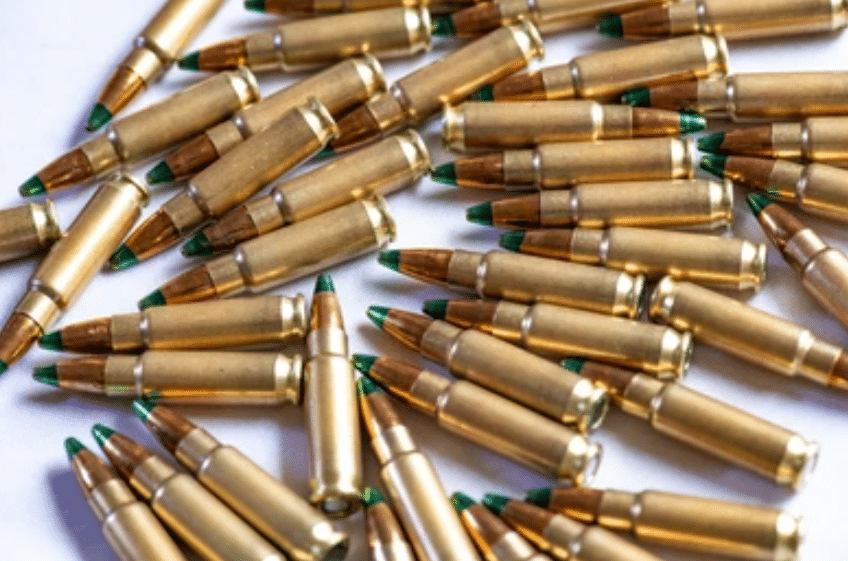I’ve been a Ruger fanboy for God knows how long. As a revolver guy, I’ve had a long love affair with their Redhawk, Super Redhawk, and SP101, and I used to own a blued GP100. In SHOT Show 2020, I was excited when Ruger announced a new pistol chambered for the rather unpopular but still kind of well-known 5.7x28mm ammo — thanks to its popularity in the military, and its notoriety among Fudds, leftist politicians, and the mainstream media as a cop killer.
Ruger has a pretty good value proposition in their new pistol, the Ruger 57 if you ever wanted to own an FN Five-seveN yet never got around to buying one (which is understandable — its price is unappealing). But as good as fanboys like myself think it is, if it weren’t for the 5.7x28mm cartridge it’s chambered for, it probably would have been just another plastic 9mm handgun.
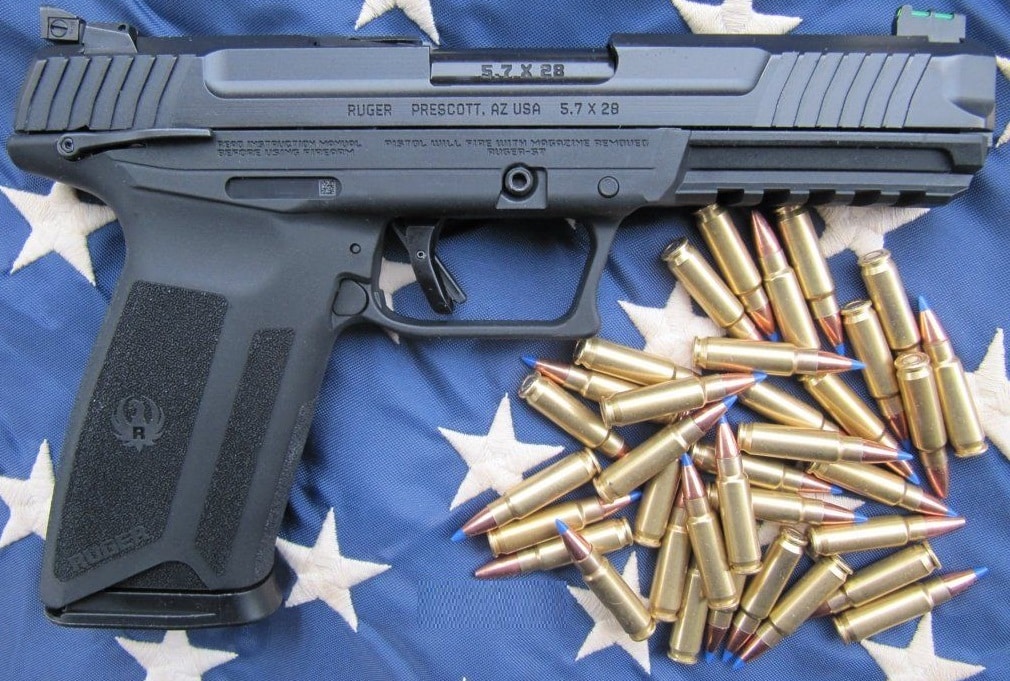
9MM vs. 5.7x28mm Ammo
Don’t get me wrong, the 9mm is a great all-around cartridge that has been around for more than a century. It wouldn’t be with us anymore if it weren’t as good as it is. But the 5.7x28mm is itself a remarkable little cartridge deserving of love and attention as well. It has a longer effective range than the 9mm, it exhibits unique terminal performance, and it has a whole slew of inherent advantages owing to its purpose-driven design.
Yet, unlike most other recent calibers of decades ago like the .40 S&W, the 10mm, and the .357 SIG, the 5.7x28mm has failed to catch on — and it shows in ammo availability and pricing. It needs all the help it could get to catch up with the top dog, the 9mm, in its race to the mainstream. The affordable Ruger-57 and Speer’s new Gold Dot 25728GD should be able to help its cause somewhat, but whether or not it would ever catch on is anybody’s guess.
You might be here because you recently purchased a firearm chambered for the 5.7x28mm and you’d like to know what types of ammo are currently available for it, where to purchase them, and how much they cost. Or maybe you’re just curious to know just how good the 5.7x28mm is because of the recent hype generated by Ruger and Speer. Whatever the case may be, you’ve come to the right place.
The 5.7x28mm’s raison d’etre
NATO was formed in the late 1940s at the insistence of the U.S. and the UK. It was originally made up of Luxembourg, France, the Netherlands, and Belgium. Not too long after, Canada, Iceland, Portugal, Denmark, Norway, Italy, and the U.S., formally joined and more than half a decade later, West Germany was eventually incorporated.

With the exception of France, the above-mentioned European countries from before NATO’s conception went into World War II armed with handguns and machine guns chambered in 9mm. During and after the war, the 9mm became the fighting man’s handgun cartridge.
Around the same time, because of the UK military’s adoption of the Browning Hi-Power, the 9mm’s soaring popularity due to its superior performance (compared to all other cartridges available to European countries at the time), and politics to some degree, the 9mm became the norm which led to NATO’s adoption.
More 5.7x28mm Ammo History
It was all well and good until the rise of early body armor in the 80s and 90s pushed NATO to start searching for an alternative cartridge that can be chambered in pistols and personal-defense weapons (PDW). The new round must be capable of greater accuracy and longer range than the standard set by the 9mm. It must also have good terminal performance against both armor-protected and non-armor-protected targets.
A handful of firearms manufacturing companies answered NATO’s call, among which was Fabrique Nationale Herstal from Belgium, more popularly referred to in the industry and among enthusiasts as FN Herstal or simply FN.
FN set out to develop a brand new cartridge and launching platform combination. Unlike a lot of “new” cartridges at the time, the 5.7x28mm was 100% new, having no parent case and made entirely from scratch. The design called for a 1.138″ long bottleneck case with a rebated rim and a 35-degree shoulder that held a .22-caliber bullet weighing 23 grains. They filed for a U.S. Patent and in 1991, their application with patent# 5,012,743 (“High-Performance Projectile”) was approved.
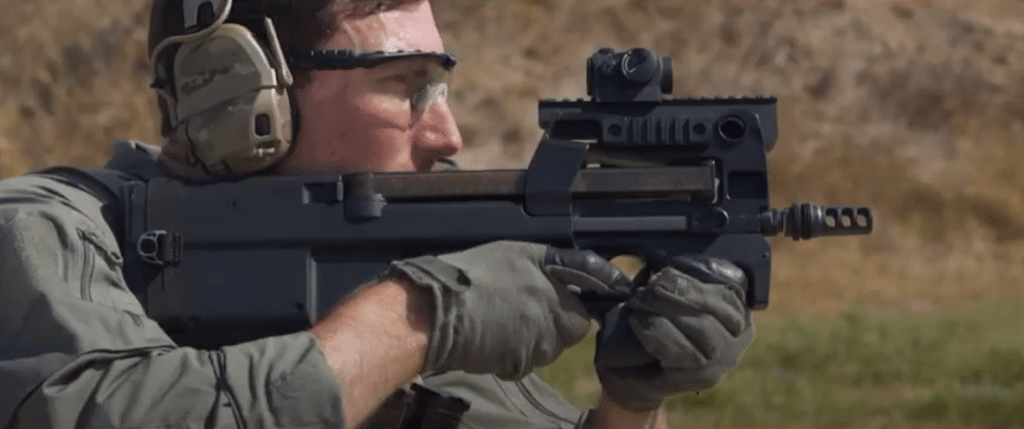
Today, over 40 nations use the 5.7x28mm in both FN’s handgun and PDW shooting platforms, including several law enforcement agencies, both federal and state, within the United States. Counter-terrorists, special forces operators, and Mexican drug cartel members seem to have developed a fondness for the cartridge and the very limited firearm models chambered for it.
What makes the 5.7x28mm ammo so different
The original 5.7x28mm cartridge weighs 6.0 grams (93 grains) or around two-thirds the weight of a typical 9mm. Because of this lighter weight, carrying 50 rounds of 5.7x28mm is significantly less burdensome than carrying 50 rounds of 9mm. For the same weight, an operator can carry more ammo (roughly 33% more), if he had a weapon chambered for the 5.7x28mm as compared to anything chambered for the 9mm.
Dimensions-wise, since the 5.7x28mm case has a smaller diameter, an operator can fit more 5.7x28mm rounds in the mag than 9mm if we’re comparing two same-sized mags with one chambered for the 9mm and the other chambered for the 5.7x28mm.
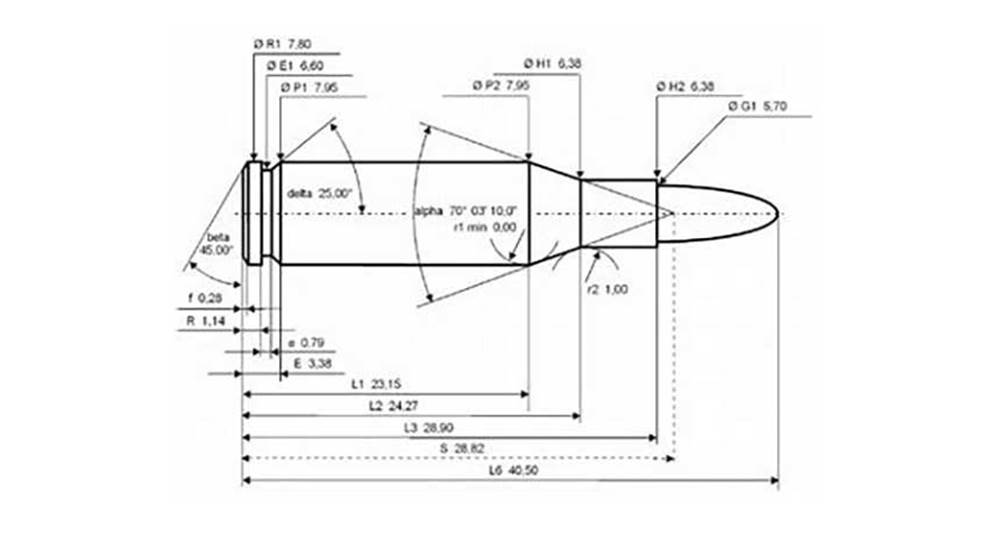
And as previously mentioned, one of NATO’s requirements for the cartridge that will replace the 9mm is, it has to be able to defeat body armor. The SS190, one of the earlier varieties of the 5.7x28mm, was designed specifically to penetrate Kevlar protective vests, e.g. the NATO CRISAT vest with 1.6 mm titanium and 20 layers of kevlar and can stop the most common handgun bullets.
The SS190 has been shown to penetrate the CRISAT vest at a maximum range of 200 meters when fired from the P90. Likewise, the same bullet out of the P90 has been shown to punch a hole through a Level IIIA Kevlar vest at the same range. Unfortunately for us law-abiding civilians, the U.S. Bureau of Alcohol, Tobacco, Firearms and Explosives (ATF) restricts the sale of armor-piercing ammo to people in the military and law enforcement.
The 5.7x28mm for self-defense
Purists claim a purported advantage of the 5.7x28mm is its ability to produce an almost deafening noise and big fireballs when fired from a pistol during nighttime. Those two things alone may be considered trivial at best inconsequential at worst, but combined with the round’s terminal performance, they can have a heavy psychological impact on whoever’s unfortunate enough to be on the receiving end of the barrel.

One-shot stops are typically a combination of all the physiological and psychological effects of being shot, and in this regard, the 5.7x28mm can be a great man stopper out of a pistol — but all bets are off when the bad guy can resist physiological and psychological pain rather well (e.g. crackheads, men of tall stature, radical Muslims, etc.).
These characters can be incapacitated quickly by way of rapid blood loss for which cartridges that can punch bigger holes are invaluable — but such cartridges can and will over-penetrate depending on the type of bullet and its velocity, resulting in collateral damage.
Compared to most common handgun calibers, the 5.7x28mm has greatly reduced chances of overpenetration because of two mechanisms: one, in general, lighter projectiles are known to lose energy rapidly upon impact; two, 5.7x28mm bullets have been shown to yaw upon penetrating soft tissue, i.e. it tumbles and wobbles off-center in all sorts of directions, making it lose even more energy faster.
For these reasons, if you’re carrying a Five-seveN or a Ruger 57 for self defense and you have to pull the trigger on a bad guy, assuming you can put the bullets in the right place, there is less likelihood of your bullets overpenetrating and hitting an unintended target.
Is 5.7x28mm ammo good for hunting?
Depending on the type of game you’re hunting, the launching platform you’re using, and if you can place a well-aimed shot, the 5.7x28mm can be a viable option for hunting due to the cartridge employing the use of light projectiles flying at high velocities.
It has been shown capable of exceptionally flat trajectory and longer effective range compared to all other pistol cartridges. It also produces negligible to non-existent recoil which allows for faster target re-acquisition and quicker, more accurate follow-up shots.
For varmint and other small game, the 5.7x28mm is an excellent option. But it has been shown all over the Internet that with good shot placement, certain loadings can be capable of taking down hog and deer when fired from the FN PS90 or any platform that has a 16-inch long barrel (like the more budget-oriented Masterpiece Arms MPA5700SST-SF Defender Carbine — if you can find one).
Certain states (e.g. Oregon) legally allow hunting pronghorn, deer, cougar and even up to black bear with any centerfire .22-caliber cartridge from either a handgun or a rifle. But you’ll need to do research on your state’s legal minimum hunting cartridge requirements just to be on the safe side.
Still, you have to keep in mind that the 5.7x28mm was not originally designed for hunting. Just because your state allows it doesn’t mean it’s okay to hunt with it. It isn’t so much a question of whether it’s legal as it is whether it’s ethical. You’ll just have to ask yourself, would the cartridge be capable of humanely killing the game animal you’re looking to hunt?
5.7x28mm ammo availability
Unfortunately, even with what seems like an endless list of advantages the 5.7x28mm has, there is a severe ammo shortage for this cartridge. The Ruger-57 has certainly generated some hype, and non-FN firearms such as CMMG’s Banshee Mk57, Diamondback Firearms’ DBX57CFB, and KelTec’s P50 will ensure that the 5.7x28mm won’t become a wildcat anytime soon. But the current pandemic situation isn’t making things easy.
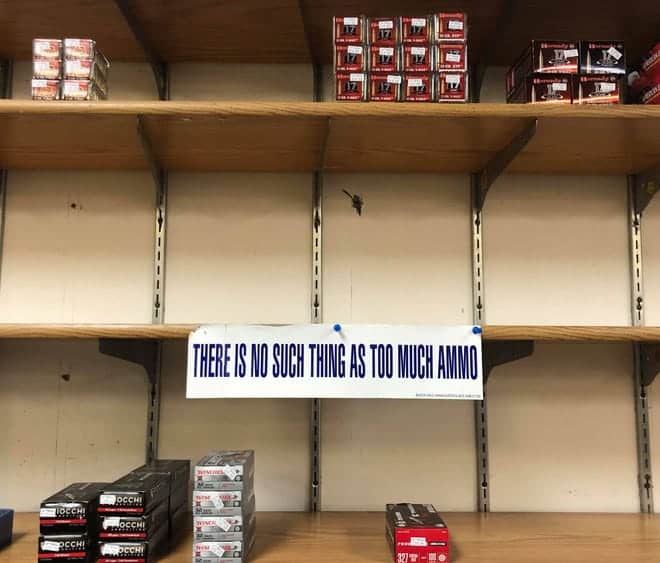
Currently, there are only three big names in the ammo industry that sell civilian loadings for the 5.7x28mm: FN, Fiocchi (marketed under both FN and Federal), and Speer. Of these three, the manufacturer with the most assortment of ammo as far as bullet types and powder loads is FN, which shouldn’t come as a surprise as they were the ones that started the whole shooting platform.
Some boutique ammo companies like Elite Ammunition, Vanguard Outfitters, and R&R Weapon Systems manufacture and sell much more potent loadings but the topic of custom hot loads for the 5.7x28mm deserves a write-up of its own. Besides, most of the stuff these companies sell are either out of stock or on backorder anyway. Largely due to the pandemic, so we’re not including anything from them for now.
Below is a quick list of available factory 5.7x28mm ammo loadings for those of you who are doing your due diligence. Do note that with all the crazy things going on at the time of this article’s writing, ammo availability is at an all-time low, and not just for the 5.7x28mm but for other calibers as well.
FN SS195LF
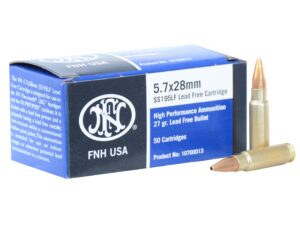
The SS195LF sporting round (LF meaning lead-free) uses a lead-free primer and a 28-grain (1.8 g) copper-jacketed, aluminum-core hollow point. It performs similarly to the ammo type it superseded, the SS192. Out of the Five-seveN, it can reach a velocity of 1,890 feet per second. Like most 5.7x28mm ammo types, SS195LF has unique identifiers: one, its primer is silver-colored; and two, the bullet has an unmarked hollow tip.
Top Gun Supply has these available for $59.95 per box of 50.
FN SS192

Replaced by the SS195LF, the SS192 round uses an unmarked 28-grain (1.8 g) copper-jacketed hollow point bullet with an aluminum core. It can only be differentiated from the ammo type that replaced it by the color of its primer. Whereas the SS195LF uses a silver-colored primer, the SS192 uses a brass-colored one. This round is not being manufactured anymore.
308Ammo has these available for $99.98 per box of 50.
FN SS198LF
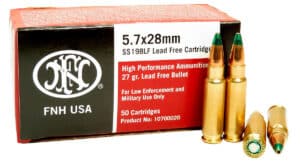
Easily identifiable with its green-marked tip, the SS198LF is simply one of the better performing 5.7×28 ammo on the civilian market today. Like the SS195LF, it has a lead-free primer and a lead-free jacketed hollow point projectile with a metallic core that is slightly lighter. Weighing in at only 27-grains (1.74g). The SS198LF bullet can reach velocities of up to 2,100 feet per second out of the Five-SeveN handgun, making it a bit more potent than the SS195LF.
MegaAmmunition has these available for $375.00 for a brick of 500 rounds.
FN SS197SR
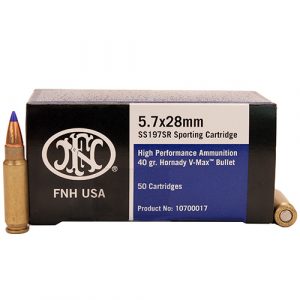
Replacing the older SS916 Sporting round, the SS197SR is manufactured by Fiocchi under contract for FN Herstal. It uses the same 40-grain (2.6 g) Hornady V-Max blue polycarbonate tip that the SS196SR used but it’s loaded a tad hotter with velocities reaching roughly 1,750 feet per second. Boxes for the SS197SR can be distinguished by the new FN blue and black labels.
Midway has these available for $51.99 per box of 50.
FN SS190
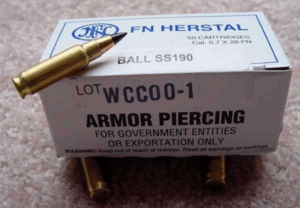
FN designates the SS190 ball FMJ as Armor Piercing (AP) ammunition. Designed to penetrate body armor up to Level IIIA, the BATF restricts sales of SS190 ammo to military and law enforcement personnel. And mandates that all unsold SS190 stock ammo should be stored by FN in a bonded warehouse. Pundits say SS190 ammo can be legally owned on a federal level. But it’s better to error on the safe side so check your state laws first. SS190 uses a 31-grain (2g) aluminum-cored steel penetrator projectile with a velocity of around 2,000 feet per second out of the Five-seveN pistol.
FN SS191 Tracer

With combustible chemicals packed in its bullet’s rear, the SS191 Tracer creates a trail (or a trace) as it is ignited by the burning propellant from the cartridge. Highly visible up to 200 meters away from the operator. The ballistic performance of the SS191 Tracer is about the same as that of the SS190 Black Tip. Its projectile is distinguishable by a painted red tip. Some people in the know refer to it by its previously designated model number, the L191. Its sales are restricted to the military and law enforcement.
FN SS193 SubSonic
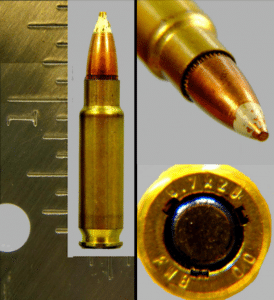
Utilizing a relatively heavier 55-grain (3.6 g) Sierra Game King FMJBT (full metal jacket boat tail) with a white-painted tip. The SS193 SubSonic was designed specifically as a low velocity ammo so it doesn’t have the obnoxious “crack” typically made by supersonic rounds. When shot in a firearm that has a suppressor attached, SS193 can be whisper-quiet. But because of its low velocity, the SS193’s performance is greatly neutered. Like the SS190 and SS191, it cannot be sold to civilians.
Federal American Eagle AE5728A
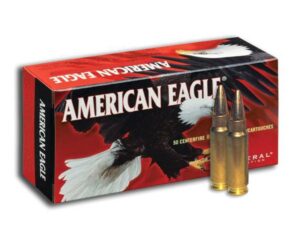
Federal Cartridge Company started selling ammo manufactured by Fiocchi some time in 2012 under their American Eagle brand. The cartridge utilizes a total metal jacket (TMJ) projectile weighing in at 40 grains (2.59g) that, when fired from a Five-seveN pistol, can achieve a velocity of roughly 1,655 feet per second. One of the cheaper ammo options today, AE5728A is being marketed for plinking and target practice.
MegaAmmunition has these available for $355.00 for a brick of 500 rounds.
Speer Gold Dot 25728GD
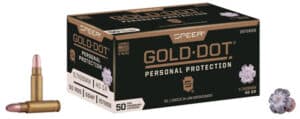
Announced by Speer just last year as the first ever 5.7x28mm loading specifically designed for self defense. The 40-grain 25728GD can reach 1,800 feet per second out of the Five-seveN. Announced in January of last year, the 25728GD uses Speer’s proprietary Uni-Cor method. The bullet’s jacket and core are bonded “one atom at a time” resulting in practically zero chances of separation. The bullet retains its mass, ensuring better penetration and expansion even through barriers.
MegaAmmunition has these available for $470.00 for a brick of 500 rounds.
5.7x28mm Ammo Conclusion
Unfortunately, even with all its advantages and the recent hype generated by companies like Ruger and Speer, the 5.7x28mm is still suffering from its relative obscurity which it totally doesn’t deserve. Ammo availability is still an issue, and high per-round prices remain discouraging in the foreseeable future.
Only time will tell whether the 5.7x28mm will ever catch up in popularity to the 9mm. The caliber it was designed to dethrone. But if you can get past all of its availability and pricing issues, the 5.7x28mm is a great little cartridge that offers much, much more than its competitors.
